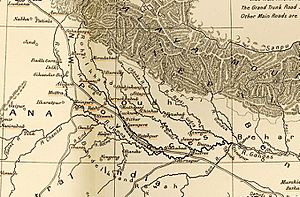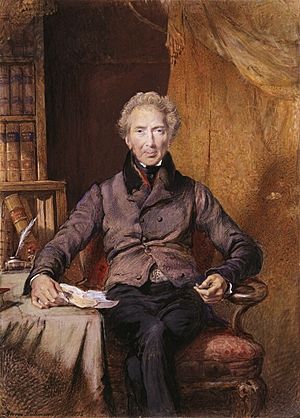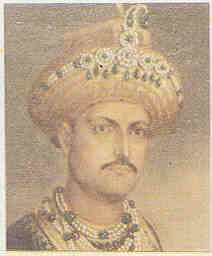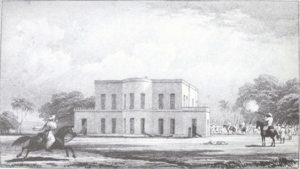Massacre of Benares facts for kids
The Benares Uprising was a small, unsuccessful rebellion led by Wazir Ali Khan in 1799. Wazir Ali was the former ruler of Awadh, a kingdom in northern India. This event happened in the city of Benares (now Varanasi). During the uprising, five British officials and citizens were killed. Wazir Ali's rebellion ended with him being imprisoned for the rest of his life.
Contents
How the Uprising Started
Oudh and the British East India Company
Oudh State, also known as Awadh, was a rich kingdom in north-central India. It was located near the Ganges River and south of Nepal. Its capital city was Lucknow. By the late 1700s, Oudh was becoming more and more controlled by the British East India Company. The Company was a powerful British trading group that also ruled large parts of India.
The British had an official called a "Resident" in Lucknow. This person's job was to gather information and make sure things happened in a way that helped the East India Company. George Frederick Cherry was one such Resident. He was very good at gathering secrets. However, he made many enemies and had to move to Benares for his own safety in 1796.
Choosing a New Ruler
In September 1797, the ruler of Oudh, Asaf-ud-Daula, died. Oudh was now a "vassal state," meaning it was under the control of the British. The British, led by Sir John Shore, the Governor-General of India, felt they had to choose the next ruler.
The choice was between Wazir Ali Khan, who was Asaf-ud-Daula's adopted son, and Saadat Ali Khan II, Asaf-ud-Daula's half-brother. At first, the British chose Wazir Ali as the new ruler. He was only 17 years old. But they quickly regretted their decision. Wazir Ali did not want to cooperate with the British. He even threatened Sir John Shore when Shore visited Lucknow.
Wazir Ali is Replaced
Soon after Wazir Ali became ruler, another important person in Oudh, Almas Ali Khan, made accusations against him. He claimed that Wazir Ali's adoption was not proper. He also said Wazir Ali was wasting money and would ruin the country.
The British decided that Wazir Ali's claim to the throne was not strong. They made a deal with Saadat Ali Khan II. Saadat Ali Khan II agreed to become the new ruler. On January 21, 1798, Saadat Ali Khan II entered Lucknow with British troops. He was officially made the new ruler.
Wazir Ali realized he could not fight the British. He agreed to leave Oudh and receive a pension (regular payments). He moved to Benares, a town on the edge of Oudh.
Wazir Ali's Rebellion
Planning the Attack
Many people wondered if it was a good idea to let Wazir Ali live so close to his former kingdom. Wazir Ali was very unhappy with his situation. He started planning against the British, hoping to get his power back.
By January 1799, the British decided that Wazir Ali needed to move even further away, to Calcutta. It was George Cherry, the British official in Benares, who had to tell Wazir Ali this news.
Wazir Ali was told about the move in early January 1799. He complained loudly to Cherry, saying the British had broken their promises. He blamed Cherry for not helping him. Wazir Ali pretended to agree to move on January 15 or 16.
The Attack in Benares
On January 14, Wazir Ali visited George Cherry for breakfast. He arrived with about 200 followers. Cherry invited Wazir Ali and three of his supporters inside his house.
While Wazir Ali was complaining, one of his associates, Waris Ali, held Cherry from behind. Wazir Ali then struck Cherry with his sword. Other members of Ali's group also attacked Cherry. Cherry managed to get out of the house but was quickly killed.
Two of Cherry's colleagues were also killed. Mr. Evans, Cherry's secretary, was stabbed and shot while trying to escape. Captain Conway, who lived with Cherry, arrived at the house and was killed by Wazir Ali's men.
Next, Wazir Ali and his group tried to attack Samuel Davis, the Magistrate of Lucknow. On their way, they found a civilian, Mr. Robert Graham, and killed him.
Davis got a quick warning when Ali's followers started shooting at his guards. He quickly took his family to the flat roof of his house. The roof was reached by a narrow staircase. Davis only had a long spear (a pike) for a weapon. For 90 minutes, he fought off Ali's followers by jabbing anyone who tried to climb onto the roof.
Wazir Ali Escapes
Wazir Ali then decided to move towards the center of Benares. Davis's house was eventually cleared by his Indian police and soldiers.
As news spread, Europeans in the town hid. Wazir Ali and his supporters did not have much time to cause more trouble. They did manage to kill a shopkeeper named Mr. Hill and set fire to some buildings.
Around 11 AM, a group of British cavalry soldiers, led by General Erskine, arrived in town. Ali and his supporters retreated towards his strong house. One of Erskine's soldiers fell from his horse and was killed. More British infantry troops arrived, and Ali's men wounded several soldiers before retreating into the garden of his house. Erskine's soldiers then surrounded the house.
Erskine used cannons to attack Ali's house, destroying a defensive tower. But during the night of January 14-15, Wazir Ali and most of his horsemen and foot soldiers escaped to the north.
He spent nearly a year hiding in the forests near the Himalaya mountains. He caused trouble in the Gorakhpur area of Oudh. Wazir Ali's situation became difficult because he could not get enough supplies for his followers, and they started to leave him.
Towards the end of the year, he sought safety with Pratap Singh of Jaipur, the ruler of Jaipur. However, the Rajah of Jaipur handed Wazir Ali over to the British. He did so on the condition that Wazir Ali would not be executed or put in chains. Wazir Ali was then imprisoned for the rest of his life.
Important papers about the Benares Uprising are kept in the National Archives.
Images for kids









